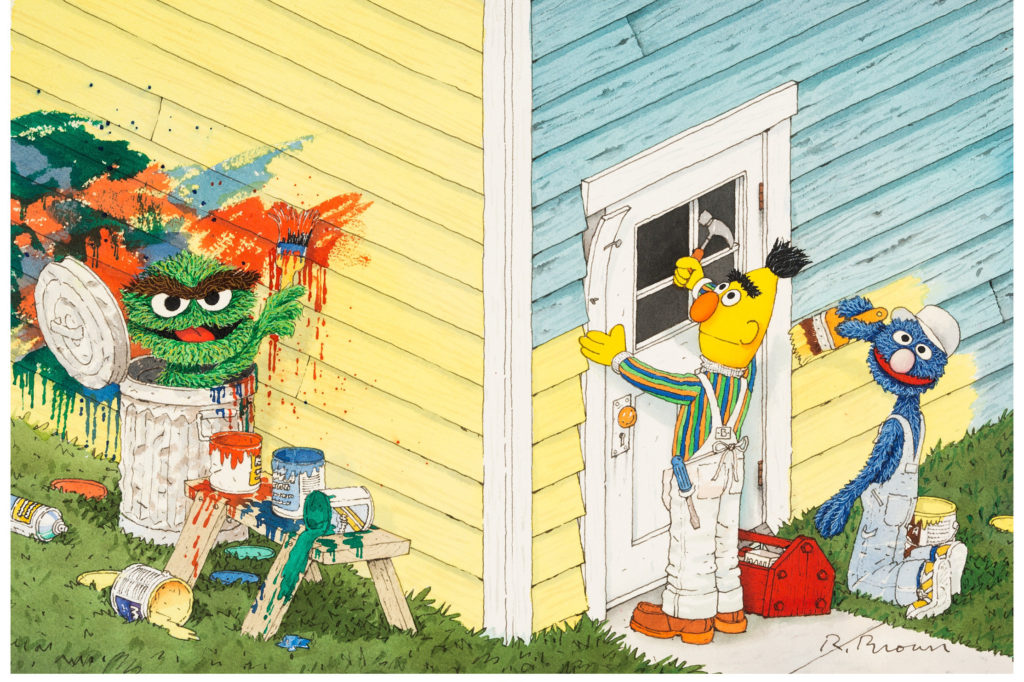
By Jim O’Neal
Can you tell me how to get to Sesame Street?
It’s a question millions of children have been asking every day for the past 50 years. In a single television season, 1969, Sesame Street became the most famous street in America, eclipsing Wall Street, Madison Avenue and even (every town has one) Main Street. So how did we get here in the first place?
Television producer Joan Ganz Cooney recalls a “little dinner party” in 1966 with her husband, Tim Cooney, and Lloyd Morrisett – an executive as the Carnegie Corporation – who asked an innocent but sincere question: “Do you think television can be used to teach young children?” In his book Street Gang: The Complete History of Sesame Street, author Michael Davis writes about Morrisett watching his young daughter sitting in front of their TV watching a test pattern, but who also knew popular TV ad jingles from memory. That sparked a lightbulb question: “What else could she learn and remember?”
Joan Ganz Cooney (b.1929) had already become interested in working for educational television through her work as a documentary producer for WNET, New York’s first educational TV station. She thought about Morrisett’s dinner-party question and answered, “I don’t know, but I’d like to talk about it.” As it turned out, they did a lot more than simply talk.
She claims none of them had any idea when they started that Sesame Street and the Children’s Television Workshop (CTW) would grow into the international institutions they are today. Or that Sesame Street, winner of more Emmys than any other show (167 Emmys and eight Grammys), would also become the longest street in the world, benefiting more children in more countries than any program in history. None of them had any idea that the characters – wonderful, zany and vulnerable Muppets that taught children about letters, numbers and getting along – would become an integral part of American culture, or that they were creating a family that every child watching would feel a part of.
They only knew for sure that they wanted to make a difference in the lives of children and families, particularly low-income children. When they began their work in the late 1960s, this seemed imminently possible. It was a time when many believed they had the responsibility and power to make the world a better place, even if only just a little better. Note: Some of us are still absolutely certain this will happen. For any doubters, just be aware that for the first time in recorded history, more than 50 percent of the world’s population is now living above the poverty line!
Sesame Street’s goal was more modest (and only in retrospect, revolutionary): to use television to help children learn (full stop)!
They knew children watched a great deal of television in the years before pre-school. They were well aware that they loved cartoons, game shows and situation comedies; that they responded to slapstick humor, music with a beat and, above all (sadly), fast-paced, oft-repeated commercials. If they could create an educational show that capitalized on some of commercial television’s most engaging traits – high production values, sophisticated writing – they could attract a sizeable audience that included, most importantly, low-income children.
There was a lot of betting against them because of the number of UHF stations in the public television system, especially in pre-cable days. But their basic instincts were almost impeccable. The wasteland was too vast and the yearning for something better too great. Sesame Street was an instant hit and remains so yet today.
On a personal note, I don’t recall ever watching it (I was 32 when it debuted), but I recall that Big Bird is 8-foot-2 and I knew Joan Ganz’s second husband, Peter G. Peterson, who she married in 1980. He was an absolutely remarkable man who was CEO of Bell & Howell and co-founder of the Blackstone Group with Stephen Schwarzman in 1985 when I was heavily involved in minority business development for Frito-Lay. He was the one who first made me aware of the implications of the national debt and the cruel burden we are passing to the next generation. Peterson’s book, Running on Empty, is still a classic, even as the situation has only gotten worse. The only one who doesn’t seem to get it is New York Times columnist and Noble Prize-winner Paul Krugman, who could easily be a character on Sesame Street if he ever learns his multiplication tables.
 JIM O’NEAL is an avid collector and history buff. He is president and CEO of Frito-Lay International [retired] and earlier served as chair and CEO of PepsiCo Restaurants International [KFC Pizza Hut and Taco Bell].
JIM O’NEAL is an avid collector and history buff. He is president and CEO of Frito-Lay International [retired] and earlier served as chair and CEO of PepsiCo Restaurants International [KFC Pizza Hut and Taco Bell].
